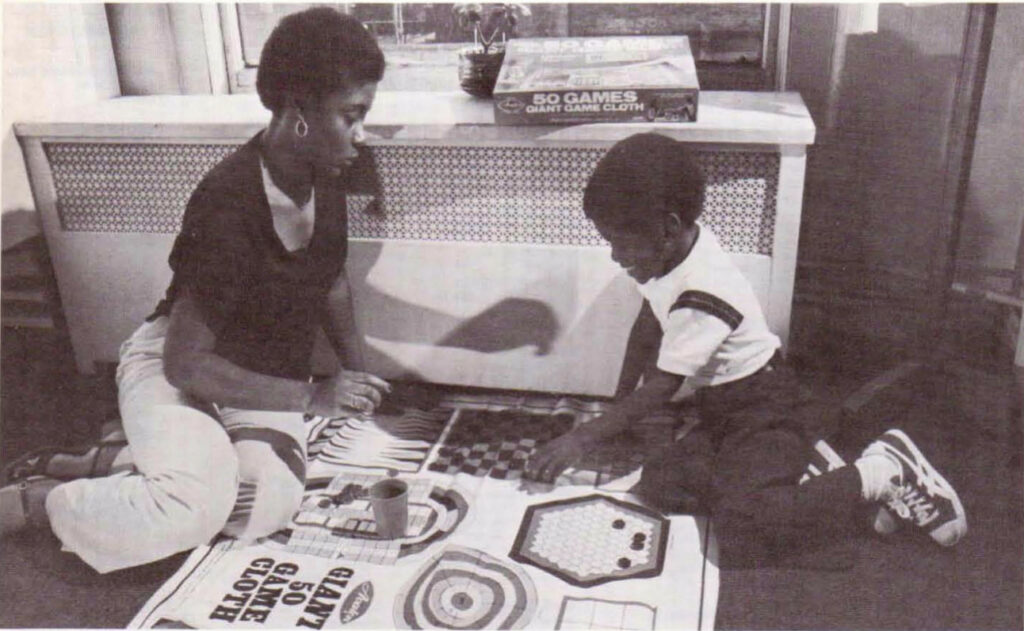
Do you ever have the feeling that your family is becoming an endangered species? Even on the rare nights when everyone is home, most often the family members are dispersed throughout the house, all enjoying their own separate forms of entertainment. This situation is further aggravated by the parents lack of time, television and the vast array of toys that act as surrogate companions for the kids. A good way to bridge this new generation gap is to take advantage of the large number of games on today’s market geared to stimulate both adults and children.
Of course, games should be fun, but entertainment value should not be the only criteria when making a purchase. Parents should look for those items that will reinforce what the children learn in school or that will arouse their imagination and broaden their capabilities. These twin goals — entertainment and education — are easily attainable through the use of the many electronic games now flooding the market.
 One of the leading sellers in the field of computerized games is Milton Bradley’s Simon. This brightly colored, battery-operated computer disc generates random signals of sounds and lights which players have to reproduce. An updated version of Simon Says, this game can help to improve a child’s sequential memory, an essential preliminary step to proper reading skills. Simon can be played by only one person, but its fun is maximized when two or more people participate. The game is programmable to suit the comprehension levels of players from age seven years old to adult.
One of the leading sellers in the field of computerized games is Milton Bradley’s Simon. This brightly colored, battery-operated computer disc generates random signals of sounds and lights which players have to reproduce. An updated version of Simon Says, this game can help to improve a child’s sequential memory, an essential preliminary step to proper reading skills. Simon can be played by only one person, but its fun is maximized when two or more people participate. The game is programmable to suit the comprehension levels of players from age seven years old to adult.
Parker Brothers’s latest success is Stop Thief, an electronic board game in which all the players are detectives. To aid you in catching the thief, the scanner emits sound clues in the form of creaking doors, footsteps and gunshots. The first player to collect $2,500 in bounty wins. In the course of discovering the culprit, youngsters sharpen their deductive reasoning and inference building skills.
In a similar vein, there is Electronic Detective, Ideal Toy Co.’s entry into the crime-solving field. The brain of the operation is the computer; only it can tell you whodunit. Suspects are briefly profiled on game cards. When you have gathered your clues and made your deductions, you accuse, but beware a wrong conclusion can find you out of the game! Because you can program the level of difficulty, it doesn’t matter whether you are a beginner sleuth or master detective.
An intriguing search and destroy game is Code Name: Sector, a submarine chase game from Parker Bros. This game of pursuit contains a computer which maneuvers an invisible sub through the sections of a nautical chart, thereby displaying the information needed to track and attack your opponent’s sub. Failure of your mission provokes immediate retaliation from the computer. Besides acquainting youngsters with nautical terminology and chart-reading techniques, Sector fosters a high level of abstract thinking and association skills.
This is but a sampling of the many electronic games you will choose from at the stores. But before you rush head-on into spending your dollars, keep in mind these helpful hints furnished by the researchers and developers at Parker Bros.
- Some toys offer more features or multi-games about the same price as the single toy. Check out and compare each company’s offering.
- The information on the box should be clear and give a concise description of how the game is played, the age range and the number of players
- Don’t buy a game just because it is novel. Its theme should interest you or the person who will be receiving it.
- A good game should be simple enough to provide fun from the onset but not so easy that it will become boring after a few hours or weeks.
- If the game runs on batteries,
- Alkaline batteries are the manufacturer’s suggested type.
- Check out the way the game or toy is put together; it must be sturdy enough to withstand frequent handling.
- Read the manufacturer’s warranty, and make sure the game is guaranteed to last for a reasonable amount of time.
- Remember to turn your games off when not in use.
If all this talk of electronics seems a bit overwhelming and you find yourself longing for games like those we played as children — games that didn’t talk, light up, out think you or carry a tune — don’t despair. Many of these games are still around, and some have been updated to offer you even greater challenges. For example, a great addition to your child’s room is Avalon’s 50 Games — Giant Game Cloth, a collection of some of our all-time favorites. Spread out this huge cloth on your child’s floor, and the two of you can challenge each other in Parcheesi, backgammon, tic-tac-toe or checkers.
Children under seven have not been neglected by the toy manufacturers. Parents can nurture the younger set’s development by joining them in a game of Candyland, Scrabble Board Alphabet, Winnie the Pooh or Missing Match-Ups. Remember, in game-land everyone gets to play!
Keep reading this issue – next article
See a list of all archived ROUTES editions
